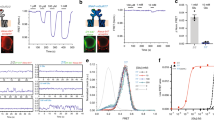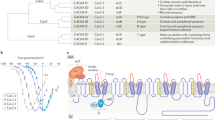Abstract
PRESENT thinking about the way that the NMDA (N-methyl-D-aspartate) class of glutamate receptor operates at central synapses relies mainly on information obtained from single-channel and whole-cell recordings from cultured neurons stimulated by exogenous NMDA receptor agonists1,2. The mechanisms that operate in the postsynaptic membrane of a normal neuron following release of the natural transmitter are far less clear. An important problem is that most normal neurons receive many excitatory synapses (103–105 per cell) and these synapses are located on slender dendritic elements far away from the somatic recording site, making the study of discrete synaptic events difficult. Typically, when populations of synapses are activated, NMDA receptor-mediated synaptic potentials appear as slowly rising, long-lasting waves superimposed on faster, non-NMDA-receptor potentials2–8. Although believed to be critical for NMDA receptor function9,10, this slow time-course would not be predicted from single-channel kinetics and its origin remains puzzling. We have now analysed the events occurring at the level of a single excitatory synapse using a simple, small, neuron—the cerebellar granule cell—which has an unusually simple glutamatergic8 input. By applying high-resolution whole-cell recording techniques to these cells in situ11, we were able to study the nature of elementary NMDA receptor-mediated synaptic currents. Contrary to expectations, the prominent currents are fast but are followed by slow ones. Both types of current are strongly voltage-dependent but differ subtly in this respect. Furthermore, the currents are absent unless glycine is provided.
This is a preview of subscription content, access via your institution
Access options
Subscribe to this journal
Receive 51 print issues and online access
$199.00 per year
only $3.90 per issue
Buy this article
- Purchase on Springer Link
- Instant access to full article PDF
Prices may be subject to local taxes which are calculated during checkout
Similar content being viewed by others
References
Ascher, P. & Nowak, L. Trends Neurosci. 10, 284–288 (1987).
Mayer, M. L. & Westbrook, G. L. Prog. Neurobiol. 28, 197–276 (1987).
Dale, N. & Roberts, A. J. Physiol., Lond. 363, 35–59 (1985).
Thomson, A. M. J. Physiol., Lond. 370, 531–549 (1986).
Collingridge, G. L., Herron, C. E. & Lester, R. A. J. J. Physiol., Lond. 399, 283–300 (1988).
Jones, K. A. & Baughman, R. W. J. Neurosci. 8, 3522–3534 (1988).
Pan, Z. Z. & Williams, J. T. J. Neurophysiol. 61, 719–726 (1989).
Garthwaite, J. & Brodbelt, A. R. Neuroscience 29, 401–412 (1989).
Collingridge, G. L. & Bliss, T. V. P. Trends Neurosci. 10, 288–293 (1987).
Gustaffson, B. & Wigstrom, H. Trends Neurosci. 11, 156–162 (1988).
Edwards, F. A. et al. Pflugers Arch. 414, 600–612 (1989).
Palay, S. & Chan-Palay, V. Cerebellar Cortex (Springer, Berlin, 1974).
Palkovits, M., Magyar, P. & Szentagothai, J. Brain Res. 45, 15–29 (1972).
Horn, R. & Marty, A. J. gen. Physiol. 92, 145–159 (1988).
Gage, P. W. Physiol. Rev. 56, 177–247 (1976).
Bekkers, J. M. & Stevens, C. F. Nature 341, 230–233 (1989).
Johnson, J. W. & Ascher, P. Nature 325, 529–531 (1987).
Birch, P. J., Grossman, C. J. & Hayes, A. G. Eur. J. Pharmacol. 156, 177–180 (1988).
Ascher, P., Bregestovski, P. & Nowak, L. J. Physiol., Lond. 399, 207–226 (1988).
Howe, J. R., Colquhoun, D. & Cull-Candy, S. G. Proc. R. Soc. B233, 407–422 (1988).
Sah, P., Hestrin, S. & Nicoll, R. A. Science 246, 815–818 (1989).
Katz, B. & Miledi, R. J. Physiol., Lond. 231, 549–574 (1973).
Thomson, A. M. Trends Neurosci. 12, 349–353 (1989).
Kleckner, N. W. & Dingledine, R. Science 241, 835–837 (1988).
Huettner, J. E. Science 243, 1611–1613 (1989).
Wood, P. L. et al. J. Neurochem. 53, 979–981 (1989).
Wilkin, G. P. et al. Brain Res. 216, 11–33 (1981).
Ottersen, O. P., Storm-Mathisen, J. & Somogyi, P. Brain Res. 450, 342–353 (1988).
Mayer, M. I. & Westbrook, G. L. J. Physiol., Lond 394, 501–527 (1987).
Author information
Authors and Affiliations
Rights and permissions
About this article
Cite this article
D'Angelo, E., Rossi, P. & Garthwaite, J. Dual-component NMDA receptor currents at a single central synapse. Nature 346, 467–470 (1990). https://doi.org/10.1038/346467a0
Received:
Accepted:
Issue Date:
DOI: https://doi.org/10.1038/346467a0
This article is cited by
-
Squaring the Circle: A New Study of Inward and Outward-Rectifying Potassium Currents in U251 GBM Cells
Cellular and Molecular Neurobiology (2020)
-
Molecular biology of glycinergic neurotransmission
Molecular Neurobiology (1997)
-
Rhythmic Cl? current and physiological roles of the intestinal c-kit-positive cells
Pfl�gers Archiv European Journal of Physiology (1995)
-
Age-dependent expression of high-voltage activated calcium currents during cerebellar granule cell development in situ
Pflügers Archiv European Journal of Physiology (1994)
Comments
By submitting a comment you agree to abide by our Terms and Community Guidelines. If you find something abusive or that does not comply with our terms or guidelines please flag it as inappropriate.



